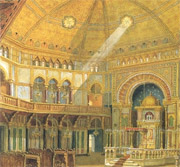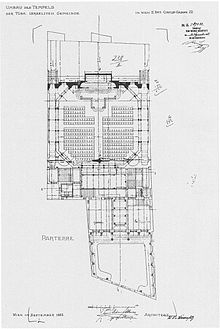Turkish temple
The Turkish Temple in Vienna was an oriental style synagogue of the Turkish-Jewish community ( Sephardim ). The building was built between 1885 and 1887 according to plans by Hugo von Wiedenfeld at Zirkusgasse 22 in Vienna's 2nd district Leopoldstadt and destroyed during the November pogroms in 1938 .
history
A small Turkish-Jewish community existed in Vienna as early as 1736 and received from Emperor Karl VI. numerous special rights. The oldest document that testifies to the existence of a Turkish-Jewish community in Vienna is from the year 1778. Above all, agreements with the government of the Ottoman Empire ( Hohe Pforte ) brought greater freedom of movement for the Turkish Jews, which also meant that after 1848 and 1867 could claim an autonomous community life. The Turkish Jews of Vienna regarded themselves as the elite of Judaism and gave great importance to the preservation of their Spanish language and the cultivation of the Sephardic rite. At the same time, the parishioners maintained close ties to the Ottoman Empire. A prayer house of the Turkish-Jewish community is first handed down from the year 1778, although the location remains unknown. In 1824 the house of prayer at that time in Obere Donaustraße was destroyed by fire and the community moved to Große Mohrengasse . However, as the number of members of the Turkish-Jewish community increased sharply, the community acquired a plot of land at Fuhrmanngasse (today Zirkusgasse) 22 and began building a new prayer house, which was opened in 1868. However, serious construction defects quickly became noticeable, so that the building finally had to be demolished. The architect Hugo von Wiedenfeld was commissioned to plan the new building, and his ideas were realized by the architect Louis von Giacomelli between 1885 and 1887 . Due to the new Israelite Law of 1890, the Turkish-Jewish community lost its independence that year and should be integrated into the Israelite religious community . After long negotiations, however, the Sephardic community was granted a certain degree of autonomy so that it could, among other things, continue its own registry management . Michael Papo, from Sarajevo , worked as rabbi at the synagogue until 1918 . After that, this position was practically no longer occupied, as his son Manfred Papo only sporadically exercised his activity as a rabbi in the Turkish temple. However, significantly was after the First World War Chief Cantor Isidor Lewit, who created their own style of singing in the style of Turkish Sephardic melodies.

The synagogue was destroyed during the November pogrom in 1938. In 1988 the City of Vienna donated a plaque in memory of the synagogue.
building
The synagogue of the Sephardic community of Vienna was built by Hugo von Wiedenfeld based on the model of the Alhambra in the Moorish style . The synagogue was built between several neighboring houses so that the entrance could only be reached via a forecourt. Synagogue visitors entered the square prayer room with its 12 meter high, octagonal dome via a vestibule . This was supported by 17 meter high surrounding walls and was illuminated by skylight windows and lanterns. The Torah shrine with the Torah , like most of the interior, was clad with marble or adorned with stucco and decorated in gold or other colors. The organ gallery was also located opposite the sanctuary. The prayer room had 314 seats on the ground floor, and there was space for a further 360 worshipers in the galleries on three sides of the room. The galleries offered 250 standing and 110 seats. In the part of the synagogue facing the street, there was also a winter bed room with 105 seats on the first floor.
See also
literature
- Pierre Genée: Vienna Synagogues 1825–1938 . Löcker, Vienna 1987, ISBN 3-85409-113-3
- Klaus Lengauer: Computer-aided reconstruction of the Sephardic synagogue in Vienna II, Zirkusgasse 22 . Diploma thesis TU-Vienna. Vienna 2007.
- Bob Martens , Herbert Peter: The destroyed synagogues of Vienna. Virtual city walks . Mandelbaum Verlag, Vienna 2009, ISBN 978-3-85476-313-0 .
- Edwin Seroussi: The Sephardic community in Vienna. History of an oriental-Jewish enclave . In: Felicitas Heimann-Jelinek , Kurt Schubert (Ed.): Central Europe. Spharadim - Spaniols. The Jews in Spain - The Sephardic Diaspora . Austrian Jewish Museum, Eisenstadt 1992, ISBN 3-900907-03-X , pp. 145–153 ( Studia Judaica Austriaca . 13).
- Adolf von Zemlinszky : History of the Turkish-Israelite community in Vienna from its foundation to the present day . According to historical data. Papo, Vienna 1888, online .
Web links
- Reconstruction of the synagogue in Zirkusgasse (Vienna)
- The Viennese Turkish-Israeli community and synagogue
- Jewish places of worship in Vienna before 1938
Coordinates: 48 ° 12 ′ 57 ″ N , 16 ° 23 ′ 2 ″ E




